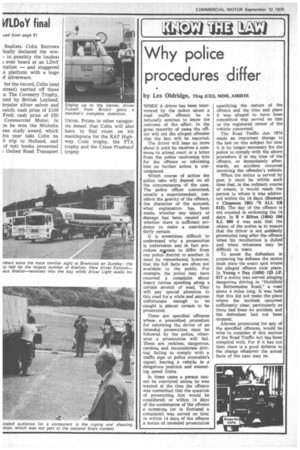Why police procedures differ
Page 54

If you've noticed an error in this article please click here to report it so we can fix it.
by Les Oldridge, TEng (CE!), MIMI, AMIRTE WHEN A driver has been interviewed by the police about a road _ traffic offence he is naturally anxious to know the outcome of the affair. In the great majority of oases. the -officer will tell the alleged offender that the -fact will be reported.
The driver will hear no more about it until he receives a summons to attend court or a letter from the police cautioning him for the offence or informing him no further action is contemplated.
Which course of action the police take will depend on all the circumstances of the case. The police officer concerned, usually a superintendent, considers the gravity of the cffence, the character of the accused, what explanation has been made, whether any injury or damage has been 'caused and whether there is sufficient evidence to make a conviction fairly certain.
It is .sometitnes difficult to understand why a prosecution is undertaken and in feet procedure ailpears to differ from one police district to another. It must be remembered, however, that the full facts are often not available to the public. For example, the police may have received a complaint about heavy lorries speeding along a certain stretch of road. They -will pay special attention to this road for a while and anyone unfortunate enough to -be caught is almost certain to be prosecuted.
There are specified offences • where a prescribed procedure for informing the driver of an • intended prosecution imust 'be followed by the police, otherwise a prosecution -will fail. These are reckless, dangerous-, careless and inconsiderate driving; failing to comply with a traffic sign or police constable's signal; leaving a vehicle in a dangerous position and exceeding speed limits.
In these cases a person cannot be convicted unless be was warned at the time the offence was committed that the question of prosecuting him would be considered; or within 14 days of the commission of the offence a summons (or in Scotland a complaint) was served on him; or within 14 days of the offence a notice of intended prosecution specifying the nature of the offence -and the time and place it was alleged to have been committed was served on him or -the registered -owner of the vehicle concerned.
The Road Traffic Act 1974 made an important change to the law -on this subject for now it is no longer necessary for the police to comply with the above procedure if at the time of the off enee, Or immediately afterwards, an accident occurred involving the -offender's vehicle.
When the notice is -served by post it must be within such time that, in the ordinary course.
of events, -it would reach the -person to whom it wasaddres sed within the 14 days. (Stewart v Chapman 1951 "2 ALL ER 613). The day -of the offence is not counted in reckoning the 14 days. In R v Bilton (1964) 108 Si. 880 it was _said that the -object of the notice. 'is to ensure that the driver is not suddenly prosecuted Jong after the offence when his recollection is dulled and when witnesses may he difficult to trace.
To assist the defendant in preparing his defence the notice must state the exact spot where the alleged offence took place.
In Young v Day (1959) 123 J.P. 317 .a notice was served alleging dangerous driving in "Hothflelel to Betheresden Road," a road about 4 miles long. It was held that this did not make the place where the incident -occurred sufficiently -clear, particularly as there had been no accident and the defendant had not been stopped.
Anyone prosecuted for any ofthe specified offences, would be wise to consider if this section of the Road Traffic Act has been compiled with. For if it ha-s not then there is a good defence to the charge whaterver the actual facts of the case may be.
















































































































